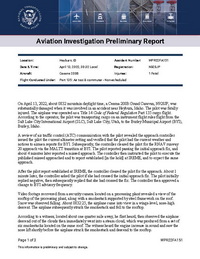
| Date: | Wednesday 13 April 2022 |
| Time: | 08:32 |
| Type: |  Cessna 208B Grand Caravan |
| Owner/operator: | Gem Air |
| Registration: | N928JP |
| MSN: | 208B2428 |
| Year of manufacture: | 2013 |
| Total airframe hrs: | 5116 hours |
| Engine model: | Pratt & Whitney Canada PT6A-114A |
| Fatalities: | Fatalities: 1 / Occupants: 1 |
| Other fatalities: | 0 |
| Aircraft damage: | Destroyed, written off |
| Category: | Accident |
| Location: | 0,7 km NE of Burley Municipal Airport, ID (BYI) -
 United States of America United States of America
|
| Phase: | Approach |
| Nature: | Cargo |
| Departure airport: | Salt Lake City International Airport, UT (SLC/KSLC) |
| Burley Municipal Airport, ID (BYI/KBYI) | |
| Investigating agency: | NTSB |
| Confidence Rating: |
A Cessna 208B Grand Caravan crashed on the roof of an industrial building in Heyburn, Idaho, USA, while attempting to land at Burley Municipal Airport, ID (BYI). The pilot suffered fatal injuries.
The aircraft departed Salt Lake City International Airport, Utah (SLC) at 07:00 hours local time (13:00 UTC) on a cargo flight to BYI.
The pilot aborted the first approach to runway 20 at BYI at 08:11. The pilot executed the published missed approach procedure and reported over IREME.
The controller then cleared the pilot for another RNAV approach to runway 20. After the pilot reported that she had crossed the initial approach fix, the controller approved a change to BYI advisory frequency.
According to a witness, the aircraft descended out of the clouds and then immediately went into a steam cloud, which was produced from a set of six smokestacks located on the roof of a processing plant. The witness heard the engine increase in sound and saw the nose lift shortly before the airplane struck the smokestack and descend to the rooftop.
The aircraft crashed 700 m north-east of the threshold of runway 20. At the time of both approaches, visibility at the airport was limited due to snowfall.
PROBABLE CAUSE:
The pilot’s failure to maintain altitude during an instrument approach, which resulted in a descent below the approach path and impact with a vent stack. Also causal was the failure of the processing plant to correctly paint the vent stacks, which had been determined by the FAA to be a hazard to navigation due to their proximity to the landing approach path. Contributing to the accident was the likely distraction/illusion/obscuration created by steam from the processing plant, which intermittently obscured the runway.
METAR:
14:01 UTC / 08:01 local time:
KBYI 131401Z AUTO 20008KT 2 1/2SM -SN BR BKN026 OVC033 M03/M05 A2996 RMK AO2 P0000 T10281050
14:10 UTC / 08:10 local time:
KBYI 131410Z AUTO 19008KT 1SM -SN BR BKN023 OVC028 M03/M05 A2996 RMK AO2 P0000 T10331050
14:40 UTC / 08:40 local time:
KBYI 131440Z AUTO 21008KT 2 1/2SM -SN BKN030 OVC047 M03/M06 A2997 RMK AO2 P0000 T10281056
Accident investigation:
 |
|
Sources:
newsradio1310.com
kmvt.com
Location
Revision history:
| Date/time | Contributor | Updates |
|---|---|---|
| 31-May-2024 07:20 | ASN | Updated [Narrative] |
| 12-Jun-2024 11:39 | ASN | Updated |
The Aviation Safety Network is an exclusive service provided by:


 ©2024 Flight Safety Foundation
©2024 Flight Safety Foundation